Photo is supplied by Mike Kalsem who brought to my attention the existence of the 4th variation
The No 6 Ratchet is easily the most interesting and innovative piece of obsolete technology. This is a speed device that allows any handle to be made into a ratchet handle. The handle and socket are not engaged, held apart by a spring, and will slip until the handle is pressed down. When collapsed, the teeth engage and torque can be applied in either direction. It is a clever and a very short-lived device. These are sometimes called Cogs, Barrel adaptors, Clutch Adaptors and by the proper name: the No 6 Ratchet Adaptor.
There are 4 known versions of No 6 Ratchet Adaptors. There are also stamping variations.
Co- founder of The Snap on Wrench Company, Joe Johnson, filed a patent in July 1920. The patent issued on January 30, 1923. The patent itself gives us a small glimpse into the time and Joe Johnson. Snap On Patent
The first version ran from 1920 to 1922 or early 1923. The device and the patent drawing are very similar. See the Patent. The photo shows “Snap on” and PAT PEND stamped into the ratchet adaptor. The 1923 catalogs shows the third version, but the first and second versions obviously exist! These first and second versions existed prior to the publication of Catalog A. Version one has 9 teeth on the top and bottom (18 total for a one tooth turn of 40 degrees). It is 3 and half inches long and a 1 and a 5/8 inch in maximum diameter – big.
Patent drawing
The second version retains the same design, but in a reduced size. It is stamped “Snap on” with a second unreadable line – probably PAT PEND. The second version has more teeth: 15 teeth on the top and bottom (30 total for a one tooth turn of 24 degrees). This is an improvement allowing the user to work in tighter spaces. The spring action is better and requires less force to engage. Version two is also pre 1923. It lasted only a few months. These are rare. It is 2 and 7/8 inches long and a 1 and a 1/8 inch in maximum diameter – Smaller than the first version.
The third version retains the ‘30 tooth’ design of the second version. The third version is still shorter. It retains the quick spring action seen is the second version. Version 3 is the most common version. Shown in the 1923 catalog it ran through 1929 or 1930. Missing from the 1931 catalog and not replaced by a new design until 1939. A similar device is still available as the No 67 Ratchet Adaptor. This third version is 2 and 3/8 inches long and the same 1 and a 1/8 inch in maximum diameter – This is the longest running design.
In the third version there seem to be variations in the stampings. The patent was issued in 1923. I have looked at 8 of these that I own. 7 are stamped Snap on and under neither PAT.1-30-23. One has the 2nd line missing (stamped before the patent issued? Or just a mistake?) Also, one is stamped upside down.
In the fourth version there is a short run fourth version that is rare and even shorter. The size may be difficult to see but these seem to be stamped in the barrel.
There is an additional mythical design rumored to exist.
A 12 tooth version advertised in April in 1922, but never found, it may be the 15 tooth version 2 filled the need and perhaps the 12 tooth version was never produced? Or it is very rare. The copy of the advertisement is Courtesy of Ken Johnson. There is a 2nd advertisement in July 1922 showing the 15 per side – 30 teeth for both. So the 15 teeth exited after July 1922. The 9-tooth version (1) exited before July 1922.
Number | Description | Date Range |
No 6 Version 1 | The largest and most course of the series of “Ratchet Adapters” | 1920-1922 |
No 6 Version 2 | A very short lived version, likely lasted a few months | July1922-23 |
No 6 Version 3 | The most common “Ratchet Adapter” | 1923-1929 |
No 6 Version 4 | Shortest “Ratchet Adapter” | 1929 |
1/2 67 variants
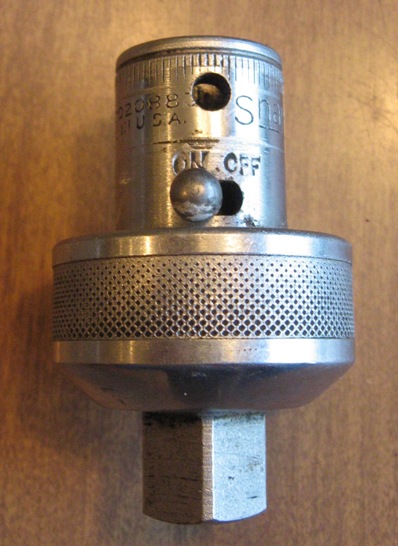
Left – 1934 flat ball detent
946 ball detent crimp style.
The No 6 Ratchet morphed into this. It exists in ¼ inch, 3/8 inch ¾ inch and ½ inch. The 3/8 and ½ inch (and maybe others) are still available new today. This is a 67A data stamped 1947
Number | Description | Date Range |
No 67 | Ratchet adapter | 1941-1945 |
67-A | Ratchet adapter | 1946 |
67-B | Ratchet adapter | 1948-1955 |
67-C | Ratchet adapter | 1958-1970 |
No 7 Ratchets 1925-1930
The patent drawing above shows a cam, and the actual are two paws, with no cam. Snap-on would feature this as superior in 1925, but switched to a reversible cam in 1931. Both drawing and actual show 15 teeth.
.
In the 1920s, the vast majority of the socket sets were ½ square drive. Every set of sockets required a set of handles and no set of handles is complete without the No 7 Ratchet. Because a No 7 Ratchet was in the hands of every customer, huge numbers of the No 7 Ratchets can still be found.
How it works. All No 7 Ratchets have a square hole for a plug. These ratchet only one way, so reversing the wrench means moving the plug from one side to the other. On the most common ratchets, the plug is removed, the ratchet flipped over and the plug inserted in the other side. A lot of the changes involved making this ‘forward – reverse’ change easier. In 1931 there was a patent to do just that and the concept for the modern ratchet obsoleted this design.
During the creation and life of the No 7 Ratchet, changes and improvements were made. There are a few features to look at:
-The number of internal paws and teeth,
-The casting and specifically the hole in the ratchet and the boss around it, -The type of plug used
How many Paws and teeth are in that wrench?: The catalogs point out: two paws are better than 1 paw, and this makes Snap-on a better ratchet. From Catalog B (1925) until Catalog G (1929). It suggests the existence of a single paw ratchet. This may be a reference to a competitor’s ratchet or Snap on’s earliest No 7 Ratchets may have been a single paw. The most likely explanation for this 1 paw 2 paw distinction comes from the patent. It is assigned to Snap-on (The design, number of teeth and timing suggest WF Klein was a Snap-on engineer) and shows a 1-paw construction. Interestingly, the patent shows a (one way) Cam. A two way cam (similar) is where Snap-on and everybody else ended up. Another feature Snap-on draws attention to are the number of teeth. The No 7 ratchet has 15 (360/15 = 24 degrees) suggesting competitor’s use only 10 or 12. (36 degrees or 30 degrees) .
Casting Name Differences:
1st is a very early No 7 from MikeKalsem, It has no hole, and the only labeling is the Snap-on name. It is unique to 1925
The first castings have no hole, are marked Snap-on, and have nothing else. The drawing for these lasted through the 1928 in the description, but the 1926 Super Service Set shows the hole. The No 7 ratchet with no hole must have existed in 1925 only
Casting Name Differences:
1st is a very early No 7, It has no hole, and it is clearly made for Snap on by Interstate Drop Forge
This ratchet is a very early one. It is probably 1925. There is a non-Snap on logo molded into the handle “DIF”. Alloy Artifacts first noticed this and explained it. “DIF” is a marking from Interstate Drop Forge, a merchant dropforge operator located in Milwaukee.
Interstate Drop Forge started in 1920 (Sherman McFedries is the founder) as a steel forging company. They made tools for Blackhawk, Snap on and other castings for Caterpillar and many others.
There is a relationship to Milwaukee Drop Forge – The OEM for the early Sockets. This relationship is unclear, but in the 1990s the factory site was the same. It is unclear if the site changed hands, or they merged or some other relationship existed. They were same entity in the 2002 when they closed.
There is another point of confusion. The documented history clearly states the pre 1923 sockets were from Line Material Company. Snap on also clearly purchased sockets from Milwaukee Tool and Forge. The machines to make sockets (“Automatics”) were purchased from Line Material Company – nine of them – and Snap on took a foreman (Ed Beduhn) from Line Material Company. Ed stayed with the company until his retirement. Confusion about Milwaukee Tool Works, Line Material Company and Interstate Drop Forge continues. These stories are confused and interwoven.
The second No 7 (top) has no patent info, the next does. Also look at the plugs
The second casting has the hole and is marked “Snap-on, Milwaukee USA”” ON” and “OFF”, but lacks the “Patent Applied For” phase. The patent was applied for Oct 13, 1927, so I assume this is 1925-10/13/1927
The third Casting Marked “Snap-on Patent Applied For” “Milwaukee USA” with “ON” and “OFF”. Clearly is made after Oct 13, 1927
The fourth Casting Marked “Snap-on”, “Milwaukee USA”,” ON” and “OFF”, Lacks “Patent Applied For” – This seems to be reasonably rare and shows a Captive Plug design. I think this is a 1930 ratchet. The reason is it is a clever feature, but not highlighted in the Catalogs, and the 1931 patent obsoleted the need for this. It was too late for the 1929 catalog and obsolete for the 1931 catalog
It have been pointed out in the excellent work at Alloy Artifacts that early ratchets were contract manufactured by Interstate Drop Forge and marked DIF, there is an excellent description of this at (http://home.comcast.net/~alloy-artifacts/so-early-sockets-p3.html).
This shows the variation in plugs and the last No 7 – with a captive plug.
There are at least 4 different types of plugs, the capped plug – this is the most common, the straight through plug, the rounded plug and the captive plug.
If the reader needs a plug, I have a few and may be able to help
Number | Description | Date Range |
No 7 Early | Marked Snap-on, no “Milwaukee”, No “on” / “off”, no “Patent applied for” and no hole | 1924/25 |
No 7 | Marked Snap-on, Milwaukee USA ON and OFF, Lacks “Patent Applied For” | 1925? |
No 7 | Marked “Snap-on Patent Applied For” “Milwaukee USA” with ON and OFF. (The application was Oct 13, 1927) | 1927?- 1929 |
No 7 | Marked Snap-on, Milwaukee USA ON and OFF, Lacks “Patent Applied For” – Captive Plug | 1929?-1930? |
By 1930/31 the modern Snap-on rotating paw design appeared and these ratchets were obsolete. Snap-on was not the only company with a level reverse, and they were not the first. The No 7 ratchet lasted from 1925 through 1930 and were dominate technology, but they were under increasing attack from competitors, The 1931 design was actually a late entry.
1st is a very early No 7 with different casting around the hole
1/2 Ratchet Holes
These are all No 7 Ratchets, the first one has a hole that is not 100% in the thicker casting, the next 3 all are. I speculate the earliest ratchets have this unreinforced hole and later ratchets reinforced the hole
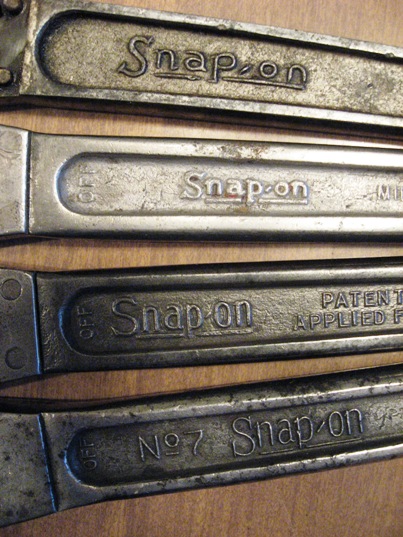
Notice the differences in the Snap on styles
1/2 Ratchet Logos
The same 4 ratchets in the same order. Notice the logos. The first logo has a large S with “feet” at the ends of the S. I think this is early. The last ratchet is labeled No. 7 – I speculate this is the newest of the 4. The 2 in the middle have no real indication of which is earlier. There are differences. The “S” has “feet” on the 2nd, the 3rd has spears. But the last ratchet also has “feet”. The 1st and the 2nd is not marked “Patented applied for” and the 3rd and 4th do.
Needle lever ratchet designs

No 71 ratchet showing the needle lever. The signiture feature of the 1931-1937 ratchets
On March 29th 1930 a man named LA Hummel filed a patent application. He had a similar application in January 30, and this application improved that 3-month-old design. (See the patent here). The patent was granted on April 1932. Hummel assigned the patent to Snap on. Snap on took this patent, improved it further and used it as the basis of all their new ½ ratchets.
There are many ratchet patents before this one, and they worked, were used by other companies and some are still in use. This patent used a rotary paw, or a cam. It is very strong, cheap and mechanically simple. It is the basis of most modern ratchets.
No 71 ratchet showing the needle lever. The signiture feature of the 1931-1937 ratchets
The cam transfers all the force into the body of the ratchet. Most earlier designs needed a very strong paw and support for that paw – this design puts the stress through, not on the paw. The paw rotates for forward or reverses with a single paw. Earlier designs generally use two independent paws or show a complex lever concept. Far from the first patent or ratchet offered with a quick-change function this design brings in most of the advantages and avoids most of the complexity. The rotary cam idea was also not unique, but putting it all together makes this patent an end point in the progression of ideas. It has two weaknesses: the spring and a weak pivot point.
A careful examination of the patent vs. the actual shows a “C” Spring vs. an “S” spring. Both drag and wear against the cover. This makes the design prone to wear, a durability weakness. However the C spring exists!!
Update: C Spring Ratchets
No 70 C spring
Update: Here is another photo from Ben Hill with a “C” Spring matching the patent. It has a cover with a 1933 date stamp. Great find.
This makes me wonder how many are out there. These are not normally pulled apart, so I am assuming these are very rare.
No 71 ratchets: the right side is the early mechanics with the “S” Spring, the left shows the last important improvement, the spring hiddlen under the base of the cam parallel to the handle – Marked with a yellow line
The next improvement moved the spring into a hole with a ball bearing (like the socket stop on a ball detent) This moves the spring into a non-rub or non-wear location.
There is another change in the cover and pivot point. On the left, the cover is machined with a pin. This pin inserts in the hole in the cam and is the pivot point, on the right, the pin is moved into the cam and a hole in the cover is the pivot point. The diameter of this arrangement is huge compared to the original. The later design is cheaper to make, stronger and removes another weakness. A full disassembly is shown is the 3/8 ratchet section.
These two improvements in the design create a basic set of mechanics that remain unchanged until today. The design domenates for > 80 years.
Progression: Needle lever ratchets 1931-1937
No 71 ratchet showing the 1931 catalog drawing and a flat lever. This is a 3/8 drive NOT the 1/2 drive. An example of a flat lever 1/2 ratchet has not been found
Introduced in the 1931 catalog, the first No 71 is shown with a flat wide level. This unique lever can be found in the 3/8-inch ratchets (shown here), but a ½ inch ratchet with this level has not been found. It may be the Catalog drawing captured a version obsoleted before publication and this tool does not exist.
No 71 ratchet Catalog Drawing from 1932
The drawing lasted through one Catalog publication and was replaced in 1932 with the needle lever. This needle lever is the signature mark of the 1931-1937 ratchets.
Opening ratchets to take a look tells us in 1932 and 1933 all use an “S” Spring; This type of spring arrangement is common in other electrical and early mechanical switches. Any locksmith or watch maker could fabracate such a spring in the 30s. No “C” spring (as shown in the patent) is known to exist. One can tell the “S” spring ratchets without disassembly by sight. If there are no screw holes through the body of the ratchet – it has an “S” spring.
Left shows a No 71 “S” Screw ratchet with a press fit cover with two button screws that appear to be added by the factory. The right shows a No 71A with the modern version with screws running through front to back ratchets
These “S” Spring No 71s had a press fit (or interference fit) cover. This type of cover can be removed by hitting the back of the gear lightly with a small hammer.
At the end of the production run, a changed occured. Snap on drilled and threaded 2 holes, adding button screws to hold or lock the cover in place.
Shortly after this, the improvement in the spring – moving this to into the base of the cavity and using a ball detent, shows up (No 71A first shown in the 1935 Catalog, but many examples exist from 1934 on)
Progression Table 1931-1937
So putting this together, there are 4 early versions of the No 71 appearing between 1930 and 1933. The first probably was not sold – the flat lever (Version 1), then the same ratchet with a needle lever (Version 2), Then incorporating 2 button screws to lock the cover on (Version 3). The last ratchets with the No 71 mark have the modern spring location and the two screws through the body.
In 1934 the castings change to show a No 71A, then changed again in 1935 to the No 71A-2 – both of which seem identical in every way other than the casting script.
The next step is the No 71-N showing a modern lever and running through WWII. Then the No 71-M running through 1965, There are variations after this explored below, but this progression really sets the standard for all modern ratchet mechanics.
Number | Description | Date Range |
No. 71 Version 1 | Flat Ratchet (Narrow switch) (20 tooth) Flat lever, S Spring, Interference Fit | 1930/31 |
No. 71 Version 2 | Flat Ratchet (Narrow switch) (20 tooth) Needle lever, S Spring, Interference Fit | 1932 |
No. 71 Version 3 | Flat Ratchet (Narrow switch) (20 tooth) Needle lever, S Spring, Interference Fit with Screw Cover | 1932/3 |
No. 71 Version 4 | Flat Ratchet (Narrow switch) (20 tooth) Needle lever, CAM, Screw Cover | 1933 |
No. 71-A | Flat Reversible Ratchet Needle lever, CAM, Screw Cover, Casting is different the Version 4 above, but mechanically identical | 1934 |
No. 71-A2 | Flat Reversible Ratchet | 1934 |
No. 71-N | Flat Reversible Ratchet with the needle lever | 1935-1937 |
No. 71-N | Flat Reversible Ratchet with the modern lever | 1939-1947 |
No. 71-M | Flat Reversible Ratchet with the modern lever | 1948-1965 |
1/2 No 71N Ratchet

Here is a WWII date stamped “E” ratchet
Here is a WWII date stamped “E” ratchet
No 71 N is basically a design that exists today
1/2 No. 71M Odd Ball
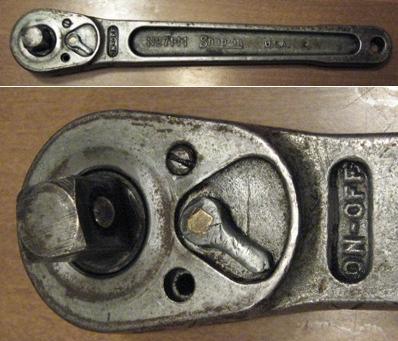
Notice the differences in the Snap on styles
Above is a ratchet that is a little rough. It is a No 71M and is date stamped 1942. The catalog listing does not appear until 1950. It then appears to be more like the 71N and not this. Here the square and the switch are on the same side. The ratchet is designed like this. I do not know the reason for this
Number | Description | Date Range |
71-N | Flat Ratchet (20 tooth) | 1936-1946 |
71NA | Flat Master Ratchet (20 tooth) | 1948 |
71-M | Flat Ratchet (20 tooth) | 1950-1965 |
1/2 Pear Head 71 Ratchets

No 71-15 ratchet with a 1940 date stamp
This is a No. 71-15 date stamped 1940. The square has been changed out. This is a classic designed pear shaped head.
Number | Description | Date |
71-10 | A ratchet handle 9 13/16 inches long (25 tooth) | 1937-1946 |
71-15 | A ratchet handle 15 inches long (25 tooth) | 1937-1946 |
71NA | Master Ratchet | 1948 |
71-B | Ratchet (25 tooth) | 1950 |
1/2 710 series Ratchets

This is a GS710 is industrial finish. It is the modern post 1948 handle design.
Number | Description | Date |
SR-710 | Master ratchet (I have a 25 tooth but 20 tooth is listed) | 1948 |
SR-715 | Master ratchet (20 tooth) | 1948 |
L-710 | Master Supreme Ratchet | 1950-1965 |
L-715 | Master Supreme Ratchet | 1950-1965 |
S-711 | Flex ratchet | 1965 |
SL-710 | Master Supreme Ratchet | 1967-1975 |
S-71 | Master ratchet (25 tooth) | 1967-1978 |
S-710 | Master ratchet | 1967-1978 |
S-711A | Flex ratchet | 1967-1978 |
S-715 | Master ratchet | 1967-1978 |
SF-710 | Compact ratchet | 1967-1978 |
SL-715 | Master Supreme Ratchet | 1967-1978 |
SF-710A | Compact ratchet | 1970-1978 |
LSF-710 | Screwdriver handle ratchet | 1975 – 1978 |
S-713 | Quick Release 32 tooth ratchet | 1978 |
S-716 | Scaffold Ratchet | 1978 |
1/2 LR-42 and LR-84 Ratchets
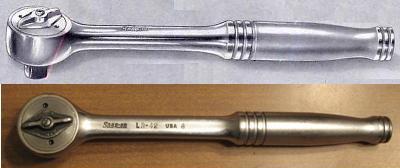
Here is a Catalog Drawing LR42 from 1953
This is a Catalog drawing of the LR42 from 1953. With the SR-84 these are the high end, fine tooth ratchets. They were expensive and uncommon
Number | Description | Date range |
LR-42 | Master Deluxe Ratchet | 1953-1955 |
SR-84 | Deluxe Master Ratchet | 1948 |
1/2 LR-42 and LR-84 Internal
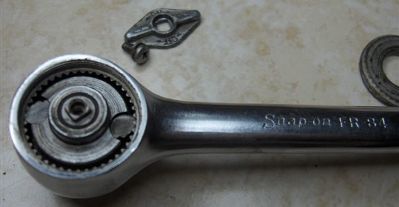
Photo courtesy of Ken and Roseanna Johnson
This wrench is the first fine tooth ratchet. It was listed only in 1948 and has an 84 bites. The description is a little hard to understand, but here is the inside of the ratchet. it has 42 teeth
1/2 Odd Ball
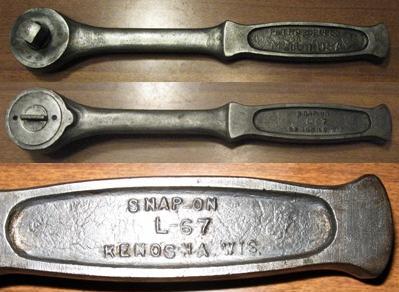
Is it Snap on? This ratchet followed no pre-existing pattern and offed no path forward.
Is it Snap on? There is no catalog listing, no reference and nobody seems to know anything, until now. Thanks to a find by Ben Hill, a date stamp has come to light and the story in obvious.
The date stamp is “G” – that places the L-67 in 1945. In addition Ben Hill observes the ratchet has the cadmium or zinc plating typical of the war era production items.
It is obvious this is a government contract build for World War II. I speculate this was a one off build. Ben caused me to pull the ratchet out of the drawer and take another look. In the casting there is a patent number. This patents is a shown here. The outside followed no pre-existing pattern and offered no path forward. Outwardly it is crude, however the inside is a little different story.
Is it Snap on? The quality of the internals say yes, the patent also proves it. Externally crude, internally it is actually a quality piece of work.
This patent is from a Snap on engineer named Gideon Gagne. The application is from March of 1934, and it was issued in November of 1935. The drawing clearly shows a 2 rotary paw design with a spring-loaded shaft.
This ratchet can be opened. The cover is threaded and using the 2 drill holes (obviously for this purpose) the ratchet comes apart. Within is the mechanical realization of the patent – 2 paws; a spring-loaded shaft on both sides and that shaft push one side or the other with the rotation of the knob from the outside. It also has a seal ring on the same side.
It is actually a great design and a surprising amount of machining work internally.
Outwardly – it is an orphan, but internally it looks like a prototype of the LR-42 and LR-84. So this odd ball turns out to actually lead to something.
Ben Hill’s l-67 showing a “G” date stamp